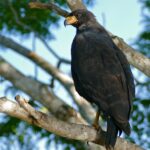Great Black Hawks (Buteogallus urubitinga) are large birds of prey known for their striking appearance and diverse diet. While they are not typically considered dangerous to humans, there are certain aspects of their behavior and ecology that could pose risks to animal enthusiasts.
Powerful Predators with a Wide Range of Prey
Great Black Hawks are powerful predators with a diet that includes a wide range of prey items, such as amphibians, fish, lizards, snakes, birds, small mammals, crabs, large insects, carrion, and even fruits. This diverse diet means that they are capable of taking down a variety of animals, including those that might be of interest to animal enthusiasts.
Territorial Behavior and Aggressive Displays
 Image source: Great Black Hawk by Bernard DUPONT
Image source: Great Black Hawk by Bernard DUPONT
Great Black Hawks are known to engage in territorial behavior, particularly during the breeding season. This can include aggressive displays and even attacks on intruders, including humans who come too close to their nests or young. While such incidents are relatively rare, they do highlight the potential risks associated with approaching these birds too closely.
Potential for Injury from Sharp Talons and Beaks
Great Black Hawks are capable of causing damage with their sharp talons and beaks. While they are not typically aggressive towards humans, they may defend themselves if they feel threatened. This could potentially result in injuries to animal enthusiasts who handle or attempt to handle these birds without proper training and experience.
Disease Transmission Risks
There is also the potential for disease transmission between Great Black Hawks and other animals, including humans. While the risk of contracting a serious disease from a Great Black Hawk is relatively low, it is still a possibility that should be taken into account by animal enthusiasts who work closely with these birds.
Legal Protections and Regulations
It is worth noting that Great Black Hawks are protected under the Migratory Bird Treaty Act of 1918 in the United States, which makes it illegal to harm or kill these birds without a permit. This means that animal enthusiasts who encounter these birds in the wild must take care to avoid disturbing them or their habitats.
Conclusion
In summary, while Great Black Hawks are not typically considered dangerous to humans, there are certain risks associated with approaching or handling these birds. These risks include the potential for injury from their sharp talons and beaks, the possibility of disease transmission, and the potential for disturbing their nests or young. Animal enthusiasts who work with these birds should take appropriate precautions to minimize these risks and ensure the safety of both the birds and themselves.
References:
– Great Black Hawk – North American Hawks – Birds of North America. (n.d.). Retrieved from https://www.birds-of-north-america.net/Great_Black_Hawk.html
– Common black hawk – Wikipedia. (n.d.). Retrieved from https://en.wikipedia.org/wiki/Common_black_hawk
– Common Black Hawk | Audubon Field Guide. (n.d.). Retrieved from https://www.audubon.org/field-guide/bird/common-black-hawk
– Great Black Hawk | The Peregrine Fund. (2021, September 6). Retrieved from https://peregrinefund.org/explore-raptors-species/hawks/great-black-hawk/.


